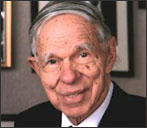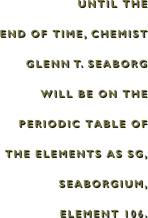

Revered chemist Glenn T. Seaborg passed away February 25 at the age of 86, but you have only to look at a periodic table of the elements to be reminded of him. Until the end of time, he will be there as Sg, seaborgium, element 106.
"That's a great honor because that lasts forever," he once told a reporter. "One hundred years from now, or a thousand years from now, it'll still be seaborgium when you'd probably have to look in obscure books to find any references to what I had done."
He was far too modest. Seaborg was one of the great chemists of the 20th century and an influential voice on national science policy as advisor to 10 U.S. presidents. A beloved Berkeley professor of chemistry for nearly 60 years, he also served as chancellor of the Berkeley campus from 1958 to 1961 and since 1971 was associate director-at-large of the Lawrence Berkeley National Laboratory.
President John F. Kennedy appointed Seaborg chairman of the Atomic Energy Commission in 1961, and he served in that position for 10 years. He championed efforts to regulate the uses of atomic energy and helped set the stage for the signing of the Limited Test Ban Treaty in 1963.
He co-discovered plutonium-238 and -239 plus nine other transuranium elements -- elements beyond uranium in the periodic table -- and led the Manhattan Project group that devised the chemical extraction processes used in plutonium-239 production during World War II. That plutonium later was used in the atomic bomb dropped on Nagasaki in 1945.
His work with transuranium elements, and a revision of the periodic table he proposed to account for them, won him in 1951 the Nobel Prize in chemistry, which he shared with Berkeley colleague Edwin M. McMillan.
Several of the elements he discovered or co-discovered were named in tribute to the university he called home. Element 97 was named berkelium, while element 98 was named californium.
In 1974, he was part of the team that discovered element 106. After much wrangling, the element was named seaborgium in his honor in 1997. He was the only scientist to have an element named after him while still alive.
Born of Swedish parents on April 19, 1912, Seaborg grew up in Ishpeming, Mich., and moved to Los Angeles when he was 10. He received his AB in chemistry from UCLA in 1934 and his PhD in chemistry from Berkeley in 1937. He joined the Berkeley faculty in 1939 and retired in 1979, only to go on to another career as an advocate for science education. He was chairman of the Lawrence Hall of Science from 1984 until his death and was a member of the National Commission on Excellence in Education, which in 1983 published the much-publicized "A Nation at Risk," a report that addressed the crisis in mathematics and science education.
Besides the Nobel Prize, Seaborg received the National Medal of Science in 1991, the Glenn T. Seaborg Medal, and the American Chemical Society's George C. Pimentel Award. He was a fellow of the National Academy of Sciences and received 50 honorary doctoral degrees. Seaborg also had an asteroid named after him.
Berkeley honored him too, with the Alumnus of the Year Award in 1948, the Clark Kerr Medal in 1984, and an endowed chair in the College of Chemistry.
He always stayed close to his Swedish roots and counted among his major awards the Great Swedish Heritage Award from the Swedish Council of America and the John Ericsson Gold Medal from the American Society of Swedish Engineers.
He is survived by his wife of 56 years, Helen Griggs Seaborg, and five of his six children: daughters Lynne Annette Seaborg Cobb and Dianne Karole Seaborg; and sons David, Stephen and John Eric Seaborg. Another son, Peter Glenn Seaborg, died in 1997.
Donations in Glenn Seaborg's memory may be made to a memorial fund at the College of Chemistry, UC Berkeley, Berkeley, CA 94720-1460; or to the Glenn T. Seaborg Endowment at the Lawrence Hall of Science, UC Berkeley, Berkeley, CA 94720-5200. Photo courtesy of LBL.
by Robert Sanders
![]()


[Table of Contents] [Berkeley Magazine Home] [UC Berkeley Home Page]
Copyright 2000, Regents of the University of California. All rights reserved.
Comments? E-mail ucbwww@pa.urel.berkeley.edu.